History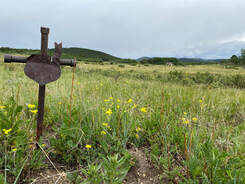
A 35-mile drive and a 3,200-foot climb through the foothills of Denver will lead you to the Central City Cemetery. This is a grouping of several smaller cemeteries and family plots that sits at a total of 8,495 feet (258 m) above sea level. The land is back-dropped by spectacular views of the Rocky Mountains and is peppered with colorful wild-flowers. The first grave-site was dug shortly after the Gold Rush period, in 1884 and the last grave was dug in 1913. It contains 17 families and groups, split between 26 cemeteries.
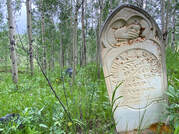
Central City Colorado is the largest town that is adjacent to the Central City Cemetery. However; many of the surrounding communities that once interred its residents here are now lost to time or ghost towns. Some such examples are; Nevadavilla and Apex Colorado. Meaning Central City and its cemetery remain, but the size of this Cemetery is attributed to many communities that no longer exist.
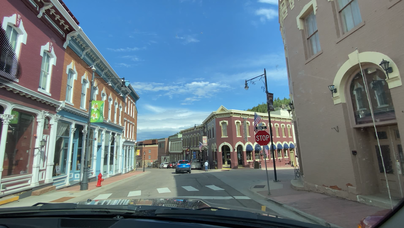
Central City was first discovered by John Gregory. Only two weeks after his arrival people began to join John and in just over two months over 10,000 people lived in Central City and it’s ancillary communities.
The area that we now know as Central City was formally incorporated by William Byers, from the Rocky Mountain News. He and his companions pitched a tent in the central square, in what was just considered a large mining district. This act elevated the area to more than a settlement and it became an emerging city center. This portion of town became known as “The Richest Square Mile on Earth”. In-fact there is a stone monument on the eastern side of the city commemorating the event. 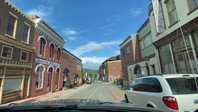
In 1874, a great fire destroyed most of the buildings in town. However; this was almost a required step for a Western city to grow out of its timber construction methods. Like many cities, they rebuilt with more sturdy materials; such as stone and brick. This is why we can still enjoy and marvel at “Ol’ Central City” to this day.
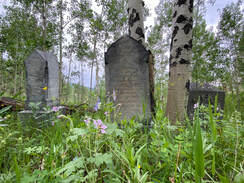
Today Central City is home to only 765 living residents; however, they are becoming well known for the thousands of residents who have passed on and refuse to leave. The Central City Cemetery is home to countless fraternal orders, secret societies, and religious sects. Some of the most well known are the “Central City Mason Cemetery”, “The Catholic Cemetery”, “Independent Order of the Odd Fellows Cemetery”, and “The Knights of Pythias Cemetery” (all of which are sub-plots within the greater Central City Cemetery”).
Knights of Pythias Cemetery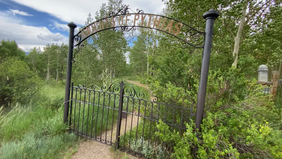
While much attention is paid to the Freemason Cemetery (and I will cover this); the Knights of Pythias Cemetery has its own set of legends and ghost stories. The Knights were the second fraternal organization to receive a charter from Congress, in 1864. They were second to the freemasons, who received a charter in 1752 (this charter was passed down from its grand lodge in Scotland before we were a country).
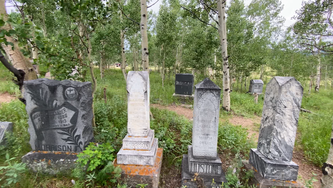
The group's by-laws and charter were inspired by a play written by Irish poet, John Banim. The play was a political satire that told the story of Damon and Pythias. The central themes of the play were of friendship and loyalty. New members were provided a sword upon their induction; however, this practice no longer exists. Today, there are about 2,000 lodges, as well as many cemeteries that are scattered throughout the country.
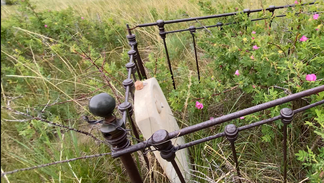
Much of this fading brotherhood’s dead lie under the Central City Cemetery with their swords by their side. The Knights of Pythias grave-site is characterized by its rod iron gates that were once topped with faux Tesla balls. Remnants of the Tesla balls are still seen on smaller fences within the plot. This was likely a nod to Nicola Tesla, who built an experimental station in a nearby town and conducted much of his research in the City of Colorado Springs. With that said, you can see how the imagination tends to run wild with a deeper connection to Nicola Tesla and the Knights of Pythias
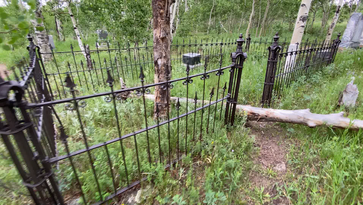
The Knights gravesite is bordered and sits across from the Independent Order of the Odd Fellows cemetery. On the border of these two sites you will find unmarked body mounds that curve skyward. There are many accounts of ghostly spirits lurking between these two burial grounds. The most frequent account is of a phantom woman, who is not from the period. Rather she wears a brightly colored red and teal track-suit; circa Mid-eighties or early 1990s. She sports short curly brown hair, yet has no face. Visitors claim to encounter her as they round corners or tree lines. Often she appears directly to the right of the passerby. Before anyone can say “excuse me” or “hello”, she disappears. These interactions have been reported to startle both the otherworldly guest as well as the passerby.
Freemason Cemetery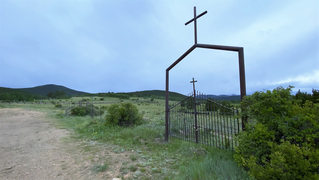
This portion of the Central City Cemetery is well maintained and is positioned away from most other grave-sites and cemeteries. The Freemason plot is the section that is often referred to as one of the “most haunted places in Colorado”.
It has been widely reported that every 5th of April and 1st of November, the grave of John Edward Cameron is visited by a woman. Unlike the Knights of Pythias spirit; this specter wears period clothing. She is said to be a beautiful young lady w ho wears a black Victorian-style dress and keeps her hair of their shoulders with a braided-chignon hairdo. She appears twice a year to lay flowers in the vase that sits directly in front of Mr. Cameron’s grave. 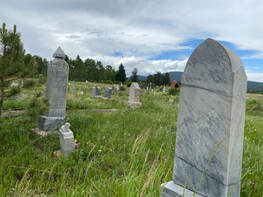
John Cameron died on November 1st, 1885, and was a member of the Freemasons. There is a lot of speculation and rumors in regards to the connection to Cameron and the “Lady in Black”. There is a record of a man named John having died November 1st from “paralysis of the heart”. It is rumored that John was a sought after bachelor. Despite the local women's advances, he was not tempted. John’s heart longed for and was devoted to a woman who lived near Bald Mountain.
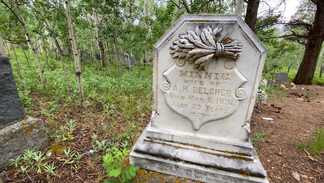
The first sightings of the Lady in Black date back to the 1880s. People speculate that the lady planted the rosebushes that once bloomed each spring beside John’s grave. The phantom-women continued to appear and deliver her bouquet of roses until June 1888, when the church-sexton removed the bushes. This seemed to stop the ghostly encounters but, only two years later the sexton saw her again. This time she carried a bouquet of columbine flowers; which bloom commonly in the surrounding meadows. He recalled that she placed the flower in the vase; reflected for a moment, before turning to Bald Mountain before disappearing.
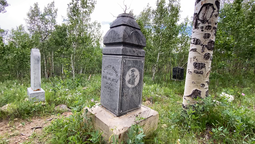
Once there were twelve paranormal investigators who gathered on Cameron’s grave and awaited her arrival. They spent most of the afternoon here and they expected a long night. However; as dusk sets in and to the amazement of the group the Lady in Black appeared. One of them attempted to approach her, when he attempted to grab her she reportedly “flew off and suddenly vanished into a nearby hillside”.
Conclusion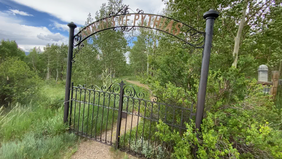
This sprawling grouping of cemeteries is mostly overgrown; however, a good portion of its residents are fortunate to have been buried in the meadows and are not likely to be overgrown. Fortunately, the majority of the damage is due to decay, not vandalism. However, to my shock, I did see a recently removed headstone, during my visit. To add insult to injury, it was a child's headstone. All that was left was a toy left in the child's memory.
The cemetery is listed as active by the Colorado Dept. of Health, who maintains the list. This list indicates that the site is now maintained by Central City. If you are interested in donating time or money to the preservation of the site please contact. The Gilpin County Historical Preservation Commission, in this link. Photos from Central City Cemetery
3 Comments
|
AuthorThank you for visiting! This is a collection of media from the lost and abandoned corners of the world. Please have a look around, I hope you enjoy. Archives
April 2022
Categories
All
|
Libraries |
Support |
|


